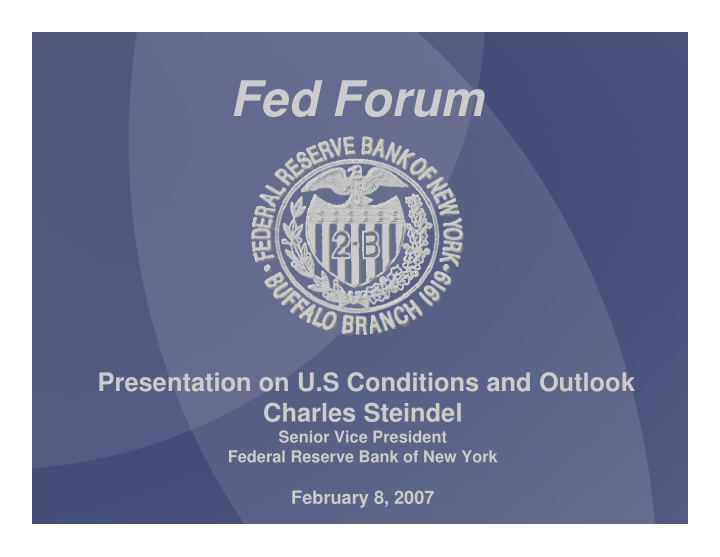



Fed Forum Presentation on U.S Conditions and Outlook Charles Steindel Senior Vice President Federal Reserve Bank of New York 1 February 8, 2007
1 Economy Entered 2007 in Good Shape • Vigorous consumer spending • Signs of levelling-off in housing • Low unemployment and strong job growth • Inflation moderating 2
2 GDP Growth, Core Inflation, and Unemployment 8 8 Fed Funds Target Rate (%) 4 4 0 0 GDP Growth 8 8 (%, AR) Unemployment Rate 6 6 4 4 Core PCE Inflation (%, AR) 2 2 0 0 -2 -2 1996 1997 1998 1999 2000 2001 2002 2003 2004 2005 2006 3 Source: Bureau of Economic Analysis, Bureau of Labor Statistics, and Federal Reserve Board
3 Retail Sales % Change - Year to Year % Change - Year to Year 12 12 Total 10 10 Excluding Autos 8 8 6 6 4 4 2 2 0 0 -2 -2 -4 -4 1998 2000 2002 2004 2006 4 Source: Census Bureau Note: Shading represents NBER recessions.
Single-Family Home Sales 4 (Seasonally Adjusted Annual Rate) Thousands Thousands 7500 1500 1400 7000 1300 6500 1200 6000 1100 New Home Sales 5500 (Right Scale) 1000 5000 900 4500 800 4000 700 Existing Home Sales 3500 600 (Left Scale) 3000 500 1992 1994 1996 1998 2000 2002 2004 2006 5 Sources: U.S. Census Bureau and Note: Shading represents NBER recessions. National Association of Realtors
5 Single Family Housing Starts Thousands Thousands 1800 1800 1650 1650 1500 1500 Housing Starts 1350 1350 1200 1200 1050 1050 900 900 1992 1995 1998 2001 2004 6 Source: Census Bureau and Mortgage Bankers Notes: Shading represents NBER recessions Association
6 Unemployment and Labor Force Participation Rates Percent Percent 8 67.6 7.5 Unemployment Participation (Left Scale) (Right Scale) 7 6.5 67.1 6 5.5 66.6 5 4.5 66.1 4 3.5 3 65.6 1993 1995 1997 1999 2001 2003 2005 7 Sources: Bureau of Labor Statistics
7 Private Nonfarm Payroll Employment (3-Month Moving Average) Thousands Thousands 400 400 Total Private 300 300 Service Producing ex. Government 200 200 100 100 0 0 Goods Producing -100 -100 -200 -200 -300 -300 -400 -400 8 1996 1998 2000 2002 2004 2006 Sources: Bureau of Labor Statistics
8 Core CPI and Core PCE % Change - Year to Year % Change - Year to Year 6 6 5 5 4 4 Core CPI Methodologically Consistent 3 3 2 2 1 1 Core PCE 0 0 1985 1987 1989 1991 1993 1995 1997 1999 2001 2003 2005 9 Sources: Bureau of Labor Statistics and Note: Shading represents NBER recessions. Bureau of Economic Analysis
9 Questions for 2007 • Can the consumer keep it up? • Is housing turning the corner? • Will inflation stay contained? 10
10 Income, Consumption, and Saving % Change - Year to Year % Change - Year to Year 8 8 Real PCE 6 6 4 4 2 2 Real after-tax Income 0 0 -2 -2 1996 1998 2000 2002 2004 2006 Percent Percent 6 6 4 4 Personal Saving Rate 2 2 0 0 -2 -2 -4 -4 1996 1998 2000 2002 2004 2006 11 Source: Bureau of Economic Analysis Note: Shading represents NBER recessions.
9 Household Net Worth Billions of Dollars Billions of Dollars 55000 55000 45000 45000 35000 35000 25000 25000 15000 15000 1990 1993 1996 1999 2002 2005 12 Source: Federal Reserve Board Note: Shading represents NBER recessions.
11 Productivity, Compensation, and Unit Labor Costs Nonfarm Business Sector % Change - Year to Year % Change - Year to Year 8 8 Compensation per Hour Output per Hour 6 6 4 4 2 2 0 0 Unit Labor Costs -2 -2 -4 -4 1990 1993 1996 1999 2002 2005 13 Sources: Bureau of Labor Statistics Note: Shading represents NBER recessions.
12 Compensation Per Hour, Employment Cost Index, and Average Hourly Earnings % Change - Year to Year % Change - Year to Year 9 9 8 8 7 7 6 6 Compensation Per Hour (Nonfarm Business Sector) 5 5 4 4 3 3 ECI 2 2 Compensation (Civilian Workers) Average Hourly 1 1 Earnings 0 0 1998 2000 2002 2004 2006 14 Source: Bureau of Labor Statistics Note: Shading represents NBER recessions.
Recommend
More recommend